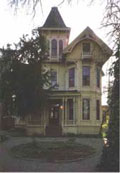|
Education
programs
School classes have been visiting the Cohen-Bray House for many
years, given tours by family members. With the help of Judith Lynch- a
historian specialist on historic houses turned school teacher, We are
creating a curriculum for school classes that will meet the state
requirements need to be met by teachers in each district.
We are developing curriculum to be given to teachers in a pre trip
teachers in service. The curriculum contains activities and
discussion topics that should be done with classes prior to coming to
the house, worksheets on things to do and see while they are on the
house tour, and follow up activities to summarize their visit and blend
it into their history/social studies curriculum already offered at their
schools.
Judith Lynch gives workshops to teachers about Alameda Historic
houses and has already created many activities that can be utilized in
the house.
The classes are divided in half and the teacher and a docent work
with half the class on the porch or in the yard doing the "hands
on" portion of the tour. A portion of the program will be done on
the Indoors back porch in case of bad weather.
This will include historic artifacts that are durable and can be
closely examined and drawn by students. We will focus on Victorian
inventions, the children will try to figure out what these things
were used for. A theme could be "A day in the life of the
Cohen-Bray Families" Family stories need to be woven through the
activities.
Activity
1. Children will choose an item to draw, then they will explain to
their classmates what they think the item might have been used for. They
then find the card that explains the item and then they talk about what
the modern counterpart is today. We need help finding items that
could be used- we need at least 10 items total. Buttonhooks, unusual
dishes, Tools would be great too.
� We will have a clothes ringer from the Ellingwood
collection that the children can use to wash clothes and pin them up
on a line.
� They will see an iron and a crimper to demonstrate how
clothes were washed and taken care of.
� We have samples of the types of clothes they wore
either in picture or sample in plastic..
2. The outside curriculum will include drawing the front and
identifying the parts of the house. (Brackets, balustrade, etc) A
vocabulary list of words will be offered to teachers as part of the
teachers� packet. A follow up I.D. sheet will be used as a post trip
review.
� We will use the house drawing and make up a master,
plus a key to identification.
� A Kitchen garden in the back would also portray what
used to be used by the family. If there is work to be done in the
garden the children could help with that. Time permitting.
� Historic maps showing where the creek run and pictures
of what it used to look like would in rich the program.
� Describing what the neighborhood used to look like with
picture and photos will help make community connections.
A docent with the help of two parents will take the other half of the
class. The inside program will tour through the parlor, library,
dining room, redwood room, breakfast room, upstairs into the front
bedroom and into Emelita's room. incorporating information about
each room.
� The presentation style will include asking questions
about colors, shapes and patterns. Which one are repeated through
out the house.
� Family history about what they did in each room will be
integrated into the tour. (xmas then and now) What happens today
with the family is important to see traditions.
� The 1906 Earthquake and changes in the house will be
included
The groups will then switch.
Special
tours for interested groups including school children are welcomed and
can be arranged by calling in advance to arrange reservations, times,
fees. (510) 527-5209.
|
